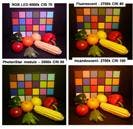Due to soaring electricity prices and ever-growing environmental concerns about energy consumption and waste disposal, lighting is experiencing a technology revolution. In the future, LED lighting offers the promise of efficiencies exceeding 150 lm/W coupled with high color rendering index (CRI), illumination-grade luminous flux levels and long lifetimes exceeding 150,000 hours. The ideal future general lighting source should also aim to emulate the color temperature and quality of sunlight at different phases of the day.
Other benefits include dimming, highspeed switching and instant-on capability, while additional features such as color control and more recently high CRI values have dramatically diversified the possible lighting applications. Architectural, mood and decorative lighting already make widespread use of RGB LED modules to provide color-changing flexibility, but these sources have suffered from poor color fidelity (typically quantified using the CRI) and poor luminous efficiency.
When LED lighting is viewed as a replacement for illumination-grade lighting, the main drawback hindering adoption is initial cost, along with issues associated with color binning, mediocre CRI and the need to achieve a good design that can meet the promised specification targets, especially for lifetime. This article reviews typical LED lighting systems that generate white light and the associated issues with binning, the impact on manufacturers and customers, and system level approaches to help alleviate the drawbacks.
+++++++
This article was published in the September/October 2008 issue of LEDs Magazine.
To read the full version of this article, please visit our Magazine page, where you can download FREE electronic PDF versions of all issues of LEDs Magazine.
You can also request a print copy of LEDs Magazine (available by paid subscription) and sign up for our free weekly email newsletter.






